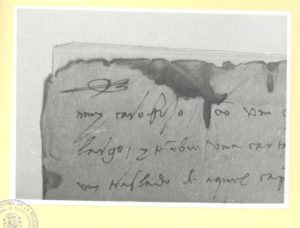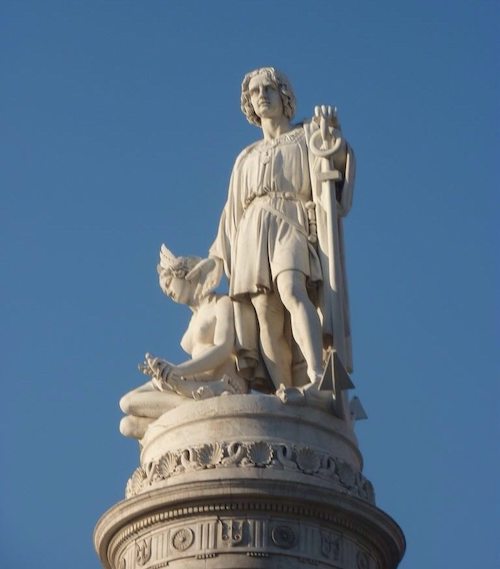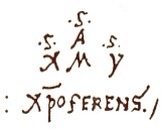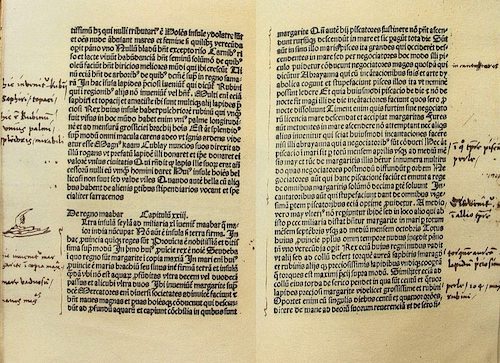As every schoolboy knows, “in 1492 Columbus sailed the ocean blue”. Since we visited Portugal and Genoa last year, I thought it might be an opportune time to revisit Columbus. According to tradition Columbus was born in Genoa and statues of him are all over the city as is the one we took above at the train station last year. A small two story house is found a few blocks behind but there is no real evidence that Columbus actually lived there. In fact, five centuries after the memorable voyage of three small ships to the new world an air of mystery remains remains regarding Columbus and the who, what, when, where and why are anything but foregone conclusions.

The “who question” is both mysterious and familiar to students of history. True luminaries are rare in history and yet seem to have a common thread related to an idea that will change the world. When the fruit of that idea arrives, often after the person dies, the historians go to work tidying up the facts. In the case of Columbus, his life before the voyage is a source of controversy, as is evidenced by an entire page on Wikipedia devoted to scholarly debate on his origins. Columbus wrote entirely in Spanish and occasionally included Hebrew, particularly in his letters to his son in the top left corner with the words, bet-hei, meaning with gods help in Hebrew. Estelle Irizarry, a linguistics professor at Georgetown University, has analyzed the language and syntax of hundreds of handwritten letters, diaries and documents of Columbus and concluded that the explorer’s primary written and spoken language was Castilian Spanish. Irizarry explains that 15th-century Castilian Spanish was the “Yiddish” of Spanish Jewry, known as “Ladino.” Throughout Columbus’s life, he referred to himself as Christobal Colom; his contemporaries and family also referred to him as such. It is possible that Colom is the shortened form of Columbus used for the Italian surname Colombo (which means “dove”). Colom can also be a Portuguese, French, or Catalan name, and in the latter means “dove”. Recently Charles Garcia has written an article for CNN detailing these and other matters asserting that Columbus could very well have been Jewish. A Genoese Cristoforo Colombo almost certainly did exist. Archives record his birth and early life. But there is little to tie that man to the one who crossed the Atlantic in 1492.
Finally there is the matter of Columbus signature as seen to the right. He wished his heirs to continue to “sign with my signature, which I now employ, which is an X [“CHI”] with an S over it, and an M with an A over it, and over that an S, and then a Greek Y with an S over it, preserving the relation of the lines and points.” The signature resembles those found on Jewish gravestones in Spain although no one has really been able to decipher it. The mysterious signature has inspired a “DaVinci Code” like book, Cecil Roth believes the signiture is a cryptic form of the Kaddish, a Jewish prayer for the dead, and the use of it by his children would allow them to say Kaddish for their father.
We will save the “what” for later and focus on the when and where. The fifteenth century was an eventful time with the death of Tamerlane in 1405 (head of the Mongols), the rapid dissolution of the Mongul empire, the taking of Cert in Morroco by prince Henry the navigator in 1415 and the fall of Constantinople in 1455. These events interrupted trade along the silk road and prompted the Portugese to search for an alternative sea route around Africa. King John I founded a navigation school in 1419 and established ports and markets in Africa. They explored several island groups including the Madeira, Azores (1427) and Cape Verde (1444). By 1488 Bartholomew rounded the Cape of Good Hope and in 1498 Vasco da Gama reached India.
At the age of 14 Columbus went to sea and by 1477 he was settled in Lisbon. In late 1481 or early 1482 Columbus sailed to the Portuguese fortress of Elmina, in what is now Ghana, on the western coast of Africa. Columbus was impressed with the riches Africa offered, especially gold. In addition, like all good navigators, he was eager to learn about winds and ocean currents from the local pilots and sailors. In the waters off the coast of Africa and the nearby Canary Islands Columbus first observed the ocean phenomenon known as the Canaries Current and the easternly winds which would become known as the trade winds.
Columbus’s idea of sailing west to get to the east was not original with him, nor did he ever claim that it was. Columbus drew upon science and knowledge accumulated over thousands of years. In Greek and Roman times, for example, geographers theorized that there was only one body of water on the surface of the Earth and that it connected Europe and Asia. If so, one could theoretically sail from the west to get to the east. Only the distance was disputed.
Columbus’s ideas of the size of the earth and the distance between Europe and Asia were based on the descriptions contained in several geographic works. These works included the 2nd-century manuscript Geography by Ptolemy; Imago Mundi (Image of the World) by Pierre d’Ailly, published in the early 1480s; and The Travels of Marco Polo, written in 1298 after Marco Polo returned from China (seen at left with notations in Latin by Columbus). Unfortunately, his ideas did not prove particularly accurate due to translation errors between ancient miles and modern equivalents and an overestimation of the size of Asia and Japan. Columbus therefore estimated the distance from the Canary Islands to Japan to be about 3,000 Italian miles (3,700 km, or 2,300 statute miles), while the correct figure is 19,600 km (12,200 miles) or about 12,000 km along a great circle.
In his first meeting with the Spanish monarchs (after being refused in Genoa, Venice, England and Portugal) King Ferdinand referred the proposal to a scientific board who told him exactly that, it was too far away! It turns out they were right. Amazingly, when Columbus finally did return from his first voyage, he was convinced that he had reached Asia (partly because the distance was roughly the same as his calculations) and in exploring the coast of Cuba, he was sure he was exploring the southern coast of China even though the native guides assured him it was an island. In fact, he called the natives “Indians”. The entire group of Caribean islands were called the West Indies, a reference to lands west of the Indus river in India which further suggests that Columbus thought he had reached Asia. An excellent reference for Columbus and details of his voyages can be found href=”http://columbus-day.123holiday.net/christopher_columbus_2.html”>here.
About half of the financing was to come from private “Italian” investors, whom Columbus had already lined up. Financially broke after the Granada campaign, the monarchs left it to the royal treasurer to shift funds among various royal accounts on behalf of the enterprise. In fact, evidence shows the investors were two Jewish Conversos and another prominent Jew. Louis de Santangel and Gabriel Sanchez advanced an interest free loan of 17,000 ducats from their own pockets to help pay for the voyage, as did Don Isaac Abrabanel, rabbi and Jewish statesman. The people of Palos were ordered to provide and equip two caravels (small, light sailing ships). The first, owned by Cristóbal Quintero, was called the Pinta; the second, owned by Juan Niño, was officially named the Santa Clara but known as the Niña. The third ship, a small, round ship with a large hold, most likely a type of vessel known as a nao, was Columbus’s flagship. It was called the Santa María and was owned by Juan de la Cosa.
In Simon Weisenthal’s book, “Sails of Hope,” he argues that Columbus’ voyage was motivated by a desire to find a safe haven for the Jews in light of their expulsion from Spain. The Alhambra Decree (also known as the Edict of Expulsion) was an edict issued on 31 March 1492 by the joint Catholic Monarchs of Spain (Isabella I of Castile and Ferdinand II of Aragon) ordering the expulsion of Jews from the Kingdoms of Castile and Aragon (not from the Kingdom of Navarre) and its territories and possessions by 31 July of that year. It is interest that Columbus left for his first voyage on August 2, 1492, a day that happened to coincide with the Jewish holiday of Tisha B’Av, marking the destruction of the First and Second Holy Temples of Jerusalem. Columbus postponed this original sail date by one day to avoid embarking on the holiday, or in deference to his Jewish financiers. There is no evidence that he sought out Jewish crewmen or settlers for his finds and immediately petitioned the Pope for a ruling making the new lands Spanish property after his first voyage. This would hardly make them a safe haven for expelled Jews.
After Columbus, many different explorers followed but in particular Amerigo Vespucci, born in Florence. At the invitation of king Manuel I of Portugal, Vespucci participated as observer in several voyages that explored the east coast of South America between 1499 and 1502. On the first of these voyages he was aboard the ship that discovered that South America extended much further south than previously thought. The expeditions became widely known in Europe after two accounts attributed to Vespucci were published between 1502 and 1504. In 1507, Martin Waldseemüller produced a world map on which he named the new continent America after Vespucci’s first name, Amerigo. The brilliant deduction that the Americas were an entirely new continent are detailed in an article from the Smithsonion and the map itself is on display in Washington.
So, who really was Christopher Columbus and did he discover America? Was he secretly a Jew and was he from Genoa? From my research it seems likely that Columbus was from Catalan in Portugal and could have been Jewish although the evidence is hardly overwhelming. In his wiil, two of his wishes — tithe one-tenth of his income to the poor and provide an anonymous dowry for poor girls — are part of Jewish customs. He also decreed to give money to a Jew who lived at the entrance of the Lisbon Jewish Quarter. He could also just have wanted to give money to the poor.
Finally, did he “discover” America? The answer is no, he brought it to the attention of Europe but Lief Erricson had discovered it centuries earlier. In fact he thought he had discovered a route to Asia as evidenced by his naming of the West Indies. Still, Combus was a visionary, with a burning desire to make his mark on the world which he accomplished almost in spite of himself.




